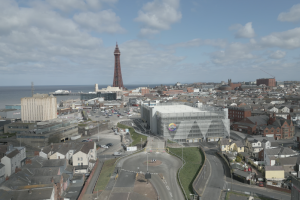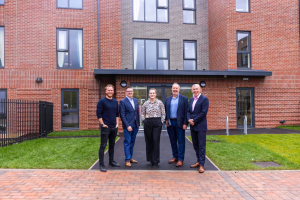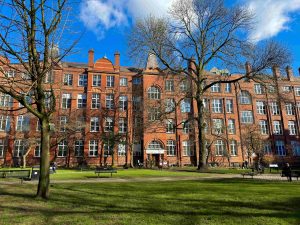In conversation with…John Downes

COMPARED with many of its peers, Langtree can be said to have had a good recession.
Its most recent set of figures show that pre-tax profits grew from £1.5m in 2010 to more than £8.9m in 2011, and that occupancy rates across its estate nudged up to 83% (2010: 81%).
However, managing director John Downes has said the Newton-le-Willows company has also been impacted by market conditions affecting its peers – not least in the market of developing commercial space for SMEs.
The company’s bumper set set of results for 2011 saw turnover grow to £54.7m (£15.1m). This substantial rise was due partly to a hike in inflation in its construction division as it completed the St Helens rugby league club stadium (now named the Langtree stadium) and an adjacent Tesco store. Langtree also completed a number of asset sales during the year and grew its rental income following a couple of acquisitions.
Downes said Langtree is currently working with the local authority in St Helens devising a masterplan for the remainder of the site.
“There’s the food retail area on the site and we’re look at uses to complement that… through leisure, perhaps. But it’s still at the early stages.
“With that, we wanted to concentrate on getting phase one completed and getting the stadium handed over. But it’s really come to life. We we there recently for the game against Leeds. The sun was shining and people were having picnics and making a day out of it.”
Despite this, he said that development remains difficult, particularly for the type of units that have been the company’s mainstay in recent years. The company was founded by chairman Bill Ainscough 30 years ago as an industrial property specialist, and has carved out a niche creating commercial and industrial units for the SME market.
“There’s still an issue there in terms of rental levels,” he said. “The cost of development is too onerous compared with returns.
“The larger enquiries are there and it’s definitely picking up in the SME space in terms of demand. I can see a situation developing where there is a shortage of available modern industrial property, but the fundamentals just don’t work at the moment.”
He said that although capital values and rents have yet to recover from the sharp fall experienced in 2008, construction costs have continued to rise, making many schemes unviable.
“In the past, developers have operated with grant support from local authorities on
Langtree is fortunate, he argues, in having a number of long-term projects on its books as well as a series of joint ventures for major projects.
For instance, it is the private sector partner at Daresbury Science & Innovation Campus, working alongside the Science & Technologies Facilities Council (STFC) and the local authority, Halton Borough Council.
The park was awarded Enterprise Zone status by the Government in August last year and it officially came into force earlier this month.
Mr Downes describes the award of Enterprise Zone status to the campus as “a real game changer” for the park.
“When you look back a couple of years, Daresbury’s future was somewhat in doubt when the decision was taken to move the Diamond synchrotron project to Rutherford, but STFC has made enormous strides since,” he said. “It’s the premium science park in UK plc terms.”
He added that the site has been widely recognised as a commercial success, with a waiting list of potential tenants, but without Enterprise Zone status funding developing new speculative units would be difficult.
Now Halton Borough council can borrow to put in the infrastructure for units and repay the money on future tax revenues generated from businesses moving into the zone.
He said that the council had responded quickly to the granting of Enterprise Zone status, which was officially granted earlier this month. A masterplan to develop up to 1 m sq ft of space at Daresbury is currently being drawn up, and Downes expects work on the first buildings to begin within 12 months.
“The Government is very keen to see some progress. They’ve given us the machinery and the appetite. We’ve just got to provide the opportunities.”
Similarly, the company is currently engaged in a placemaking exercise at Hollinwood in Oldham with the local council, with whom it signed a development agreement last year. They are currently looking to secure upfront loans to clear sites (by removing a decommissioned gas holder and add infrastructure) to provide “oven ready plots for potential investors.
The partners are also speaking to neighbouring landowners looking to bring forward similar developments to ensure schemes link with each other.
“The more people you can get acting in concert, the bigger the amount of land you can bring forward. There’s no formal alliance of landowners yet, but there are discussions and it would make sense for us to work together.”
Work on the restoration of the Festival Gardens site is close to completion, with the site in Liverpool set for its long-awaited opening within the next few weeks.
The gardens restoration has taken longer than anticipated due initially to a public inquiry process and main contractor Mayfield Construction subsequently being placed into administration in July last year.
Following this, remedial work was required to parts of the site, but Downes said that a silver lining to the late opening is that mature landscaping areas have been given a chance to bed in.
“It upsets me at times that people talk only about the delays… We’ve taken every setback that’s been thrown at us and we’ve carried on.”
He added that once visitors get the chance to use it, they’ll appreciate the finished project.
“But for us the restoration of the Festival Gardens was a means to an end. We’re looking forward to the part where we can open it and we can turn our attention to the development part because it is a cracking site.”
The 27 hectare site has outline planning permission for a £250m development containing 1,300 new homes across 26 blocks, with retail and commercial units spread throughout the site. Downes said he expects plenty of demand from housebuilders for the plots.
“The good locations will go first. This site is on the water, next to a park and a train station. It’s got a lot going for it.”








